Designing The FuTure OF WOrk is All AbOuT TrADe-OFFs
 - Ollie Henderson, Experienced CEO/Founder and Speaker, Future Work/Life
- Ollie Henderson, Experienced CEO/Founder and Speaker, Future Work/Life

FEBRUARY 2023 • Vol. 10 • No. 02 (ISSN 2564-1972) The Future of Work
Page 19 - 30
by: Themed Edition on The Future of Work
2025
Sponsored
Themed Edition on The Future of Work
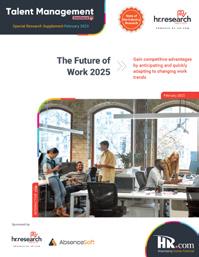
On the Cover
17 Train Individuals, Not Employees
A human-centric approach to talent management

- Craig Goodliffe, CEO and Founder, Cyberbacker
33 How To Set Salary Ranges That Are Useful, Fair, And Explainable Shifting mindset from pay management to pay explainability
- Nancy Romanyshyn, Director, Pay Strategy & Partner Success, Syndio
42 To Plan Your Career, Use The Right Tools
Choosing a new path can be daunting, but it’s also an incredible opportunity
- John Hackston, Head of Thought Leadership, The Myers-Briggs Company
Designing The Future Of Work is All About Trade-Offs
How can you turn the fundamental shifts in work and the labor market into positives?
- Ollie Henderson, Experienced CEO/Founder and Speaker, Future Work/Life
48 What Meeting Data Tells Us About Attrition
Understanding the trends can empower organizational leaders
- Mike Tolliver, Product Management Director, Vyopta
07
in D e X
Talent Management Excellence FEBRUARY 2023 Vol.10 No.02
(ISSN 2564-1972) The Future of Work 2025 Page 19 - 30
The Future of Work Trends: 17 Business Leaders Share Their Predictions
Four-day workweek, employee flexcations, Web3 and more
- Brett Farmiloe, CEO and CHRO, Terkel.io
Trends That Will Dominate The Workplace In 2023

Key strategies for future success in attracting, hiring, and retaining top talent
- Allie Kelly, Chief Marketing Officer, Employ Inc.
How To Stop Unwanted Turnover Before It Hurts You


Use an engagement mindset to retain top talent

- Cyndi Wenninghoff, Director, Employee Success, Quantum Workplace
Top Picks 10 31 37 45
Bridging Multigenerational Staff Divides In The Workplace
Three ways to improve culture
- Christopher Pappas, CEO and Founder, eLearning Industry
INDEX
How are our Talent Management Products and Services helping to make you smarter?

Talent Management Excellence - Monthly Interactive Learning Journal
This monthly interactive learning experience captures key metrics and actionable items and keeps you focused on your Talent Management Needs.
Talent Management Webcasts for Credit
Talent Management Virtual Events

Talent Management Virtual Events will help individuals who deal with the different areas in talent management get a better understanding of the big picture of their organization. Manage performance and talent effectively by studying topics from compensation and incentives, technologies, and compliance to managing and tracking performance of an organization, a department, employee, or even the processes to build a product or service. Each Virtual Event consists of up to 10 credit webcasts.
HR.com webcasts deliver the latest Talent Management industry news, research trends, best practices and case studies directly to your desktop. Webcasts are available live online with a downloadable podcast and a copy of the slides (PDF) available before and after each webcast. Earn all of the required recertification credits for aPHR, PHR, SPHR, GPHR, and SHRM Certifications. HR.com’s one-hour webcasts, in every HR specialty including Talent Management, are pre-approved for HRCI and SHRM credit (excluding Demo webcasts).
Talent Management Community
Join almost 120,000 HR.com members with a similar interest and focus in the Talent Management Community. Share content and download research reports, blogs, and articles, network, and “follow” peers and have them “follow” you in a social network platform to communicate regularly and stay on top of the latest updates. This well established Talent Management Community is an invaluable resource for any HR professional or manager.
Use these invaluable Talent Management resources today! For more information phone: 1.877.472.6648 | email: sales@hr.com | www.hr.com
Editorial Purpose
Our mission is to promote personal and professional development based on constructive values, sound ethics, and timeless principles.
Excellence Publications
Debbie McGrath

CEO, HR.com - Publisher
Sue Kelley Director (Product, Marketing, and Research)
Babitha Balakrishnan and Deepa Damodaran Excellence Publications Managers and Editors
Talent Management Excellence (ISSN 2564-1972)
Babitha Balakrishnan Editor
Chinnavel Design and Layout (Digital Magazine)
Chandra Shekar and Vibha Kini Magazine (Online Version)
Submissions & Correspondence
Please send any correspondence, articles, letters to the editor, and requests to reprint, republish, or excerpt articles to ePubEditors@hr.com
For customer service, or information on products and services, call 1-877-472-6648
Debbie Mcgrath Publisher, HR.com
babitha balakrishnan Editor, Talent Management Excellence

The Future of Work: What Can You expect?
Overthe past three years, we have experienced major changes in the ways work is accomplished. Initially driven by the Covid-19 pandemic, flexible work arrangements have become new normal in today’s organizations. A wide range of challenges and opportunities continue to quickly drive changes in the workplace.
Along with new approaches to work, technological advancements including the adoption of AI and advanced data analytics will drive continued changes to the most prevalent workplace trends.
In 2023, organizations must continue to adapt to the workplace needs of their employees, especially in light of the disruptive shifts in the workplace.
To learn more about how HR professionals view current trends and how they believe the world of work is likely to evolve over the next three years, the HR Research Institute conducted an exclusive study entitled The Future of Work 2025. Check out the report summary and download the complete report inside.
There’s an inherent complexity in taking a more multi-dimensional approach to work/ life design, which increases significantly with larger organizations. By accepting and embracing the trade-offs involved, we have the collective opportunity to design a more personalized approach to work. Learn how to reimagine work that allows you to attract the best talent and grow in Ollie Henderson’s (Future Work/Life) article, Designing The Future Of Work Is All About Trade-Offs.
From shifting to a four-day workweek to employee flexcations and Web3, check out top predictions shared by leaders on the future of work and how they are preparing for these trends in Brett Farmiloe’s (CEO/
CHRO, Terkel.io) article, The Future of Work Trends: 17 Business Leaders Share Their Predictions.
Despite flashy headlines about tech sector layoffs and recession fears, the labor market is still tight, and hiring quality talent will remain a challenge for the foreseeable future. Check out key strategies for future success in attracting, hiring, and retaining top talent in Allie Kelly’s (Chief Marketing Officer, Employ Inc.) article, Trends That Will Dominate The Workplace In 2023.
Regardless of the business climate, we must make sure our retention strategy is working for us. Check out Cyndi Wenninghoff’s (Director of Employee Success, Quantum Workplace) article, How To Stop Unwanted Turnover Before It Hurts You for three ways leaders can address turnover.
In brief, organizations that embrace new ways of working, prioritizing career development, maintaining a strong corporate culture and adjusting to employees’ expectations will thrive in the world of work ahead. Read the February edition of Talent Management Excellence for insightful articles on the future of work, trends that will dominate the workplace in 2023, employee retention strategies, and much more.
We hope you find the articles in this issue informative and helpful and, as always, we welcome your valuable feedback and suggestions.
Happy Reading!
Disclaimer: The views, information, or opinions expressed in the Excellence ePublications are solely those of the authors and do not necessarily represent those of HR.com and its employees. Under no circumstances shall HR.com or its partners or affiliates be responsible or liable for any indirect or incidental damages arising out of these opinions and content.
eDiTOr’s nOT e
OR For Advertising Opportunities, email:
Copyright © 2023 HR.com. No part of this publication may be reproduced or transmitted in any form without written permission from the publisher. Quotations must be credited.
sales@hr.com
Talent Management Excellence is published monthly by HR.com Limited, 56 Malone Road, Jacksons Point, Ontario L0E 1L0 Internet Address: www.hr.com Subscribe now for $99 / year And get this magazine delivered to your inbox every month Become a Member Today to get it FREE! SIGN UP Write to the Editor at ePubEditors@hr.com
In a world of unparalleled challenges (global pandemic, racial injustice, political rivalry, digital 4.0, emotional malaise), uncertainty reigns. Finding opportunity in this context requires harnessing uncertainty and harnessing starts with reliable, valid, timely, and useful information. The Excellence publications are a superb source of such information. The authors provide insights with impact that will guide thought and action.

Excellence publications are my ‘go-to’ resource for contemporary and actionable information to improve leadership, engagement, results, and retention. Each edition offers rich and diverse perspectives for improving the employee experience and the workplace in general.





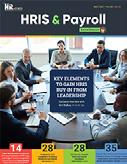
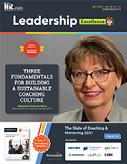
I regularly read and contribute to Leadership Excellence and Talent Management Excellence. I use many of the articles I read to augment my own presentations and I often share the articles with my clients. They are always quick, right on target for the latest issues in my field, and appreciated by my clients. If you want to stay up to date on the latest HR trends, choose a few of the different issues from the Excellence series of publications.

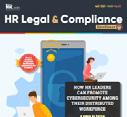

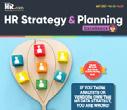

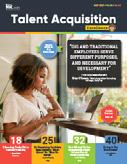

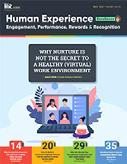 Dave Ulrich
Rensis Likert Professor, Ross School of Business, University of Michigan Partner, The RBL Group
Julie Winkle Giulioni Author, Virtual /Live Keynote Presenter, Inc.’s Top 100 Leadership Speakers
Dr. Beverly Kaye CEO, BevKaye&Co.
Dave Ulrich
Rensis Likert Professor, Ross School of Business, University of Michigan Partner, The RBL Group
Julie Winkle Giulioni Author, Virtual /Live Keynote Presenter, Inc.’s Top 100 Leadership Speakers
Dr. Beverly Kaye CEO, BevKaye&Co.
WHY EXCELLENCE PUBLICATIONS?
We’re eager to hear your feedback on our magazines. Let us know your thoughts at ePubEditors@hr.com
Designing The Future Of Work is All About Trade-Offs
how can you turn the fundamental shifts in work and the labor market into positives?
By Ollie Henderson, Future Work/Life
Whenmaking big changes – whether at work or in life – it’s easy to resort to binary thinking – things must be one way or another. But these decisions needn’t exist at extremes. There’s always a spectrum across which lies the best and most appropriate solution.
Take hybrid work, for example. Initially, the debate was whether remote or in-office was best.
Now, we’ve moved on to how many days in the office we need each week. Progress, I suppose, but such a limited scope means we might just have the worst of both worlds:
● The misguided assumption by businesses that by simply congregating for a couple of days you inherently create magic.
● And irritated employees who have become accustomed to having autonomy over their time.
The reaction to this conversation is no less problematic.
When disgruntled workers express their misgivings about having to return to the office, there’s a chorus from a certain group
Submit Your Articles
by HR.com February 2023 7
Talent Management Excellence presented
COVer ArTiCle
(typically of vested interests and with a more old-fashioned view of the world) that “you should be careful what you wish for.” As their analysis goes: for businesses employing fully remote teams, they may as well be in Bangalore or Bangkok as Basingstoke, Baltimore or Berlin.
The thing is, they’re rightthe development of a global workforce is well and truly in motion, and there’s no point pretending otherwise.
But rather than considering this as a chance to reimagine work and create new opportunities for your business and people (wherever they’re based) to thrive, it’s delivered as doom-mongering.
So what should you do instead?
How can you turn these fundamental shifts in work and the labor market into positives?
Well, try pausing and analyzing what ‘ideal’ looks like. Suppose you regard in-person interactions to add significantly to company culture, productivity, and creativity. How much will you sacrifice for a bigger talent pool to satisfy your hypothesis? I mean, literally, how much?
● Do you believe having a physical space and consistent IRL (in real life) connection adds 30% to the bottom line?
● 10%?
● 5%?
Now, weigh that up against the upside of a wider talent
net to support your company’s growth. Without a doubt, a global market means your ability to hire top-caliber people increases. So, how much will that contribute to the growth of your business?

● Will it add 30% to the bottom line?
● 10%?
● 5%?
You see where I’m going with this, right?
It’s a trade-off.
If you believe the talent benefit will increase your growth by 50%, while the hybrid work strategy would contribute a 10% upside, it’s easy to see the best approach - go remote. If the difference is
Submit Your Articles Talent Management Excellence presented by HR.com February 2023 8
Designing The Future Of Work Is All About Trade-Offs
marginal, then perhaps you take a hybrid approach, focusing on building the best possible workspace to bring the best out of your team. It’s often tricky to quantity these things exactly, but it’s not impossible.
And since the world has so dramatically changed, you don’t need to stick to the same rules as before.
Break it down by team or department: some roles and functions lend themselves to distributed teams, and others perform better when they work together in the same physical space.
For those who benefit from proximity, what’s the optimal frequency? Every week, every month, every quarter? Many of the most successful remote-first businesses schedule a regular company get-together every quarter, which is enough to build trust and familiarity within teams and across departments. Others thrive being in the same space every day, something it’s impossible to recreate over a video call.
Rather than settling for the simple binary choice, take a future-focused mindset and explore how reimagining work will allow you to attract the best talent and grow.
so how can you build a model that helps develop a growth culture?
Follow the principles I’ve written about in Work/Life Flywheel.
Mindset: Understand what matters to people and ensure their values and goals align with the business.
��reativity: The difference between the best and rest? Their ability to think differently and act creatively. Unleash it!
approach to work/life design, which increases significantly with larger organizations. But the data is there if you look for it, whether in feedback from managers and employees or in surveys and engagement data. Like any great leap forward, the journey won’t be straightforward. But by accepting and embracing the trade-offs involved, we have the collective opportunity to design a more personalized approach to work.
��xperimentation: The most innovative companies constantly test and learn. Embrace this philosophy with how people work (e.g. encouraging side projects and cross-department deployments).
��ommunity: People value connection, but don’t restrict yourself to the most obvious options. Think beyond just remote or hybrid to new ways of building relatedness and community.
��earning: Constant progress and growth are critical to those who make a difference in your business’s success. Prioritize developing systems for formal and informal learning.
��reakthroughs: Nothing great comes if you’re burnt out with no time to stop and reflect on your progress. Create a culture that encourages people to schedule downtime proactively
There’s an inherent complexity in taking a more multi-dimensional
And be in no doubt, the businesses that get this right will be those that flourish.
Experienced Founder and CEO, Ollie Henderson, pivoted his career while juggling the pleasures and pressures of raising a young family. Ollie’s weekly newsletter, Future Work/ Life, provides news and analysis to thousands of people interested in the future of work, covering subjects like creativity and innovation, data and technology, peak performance, productivity, well-being, and workplace culture. He is the author of Work/Life Flywheel: Harness the work revolution and reimagine your career without fear, published by Practical Inspiration Publishing.

Submit Your Articles Talent Management Excellence presented by HR.com February 2023 9
Would you like to comment?
Designing The Future Of Work Is All About Trade-Offs
The Future of Work Trends: 17 business leaders share Their Predictions
Four-day workweek, employee flexcations, Web3 and more
By Brett Farmiloe, Terkel.io
Fromforeseeing recession-based retention issues to needing digital depth, here are 17 answers to the questions, “Can you share any helpful predictions about the future of work and how you’re preparing for these trends?”

● Talent Retention Challenges Due to Economic Recession
● Managers Are Going to Need More Support
● Power Will Be Shifted in the Workplace
● Executives Will Focus on Employee Experience
● Get Used to Hearing About Web3
● More DEI Initiatives Across the Employee Life Cycle
● Quiet Hiring Requiring Some Thought
● Serious Career Pathing vs. Hiring Freelancers
● Robust Development Efforts Will Curb Employee Churn
● Switching to Four-Day Working Weeks
● Employers Will Focus on Employee Well-Being
● Increased Adoption of AI and Automation
● Creative Solutions Needed to Attract Service Workers
● A Focus on Psychological Wellness
● The Great Reset: Evaluate Before Making More Change
● More Remote Employee “Flexcations”
● Leaning into Digital Depth
Submit Your Articles Talent Management Excellence presented by HR.com February 2023 10
Top Pick
Talent retention Challenges Due to economic recession
Because of the impending economic recession, it will be increasingly hard for businesses to retain their top talents. Generally, during a recession, employees are more inclined to feel uncertain about their financial stability and work satisfaction, which often leads them to find new opportunities and leave their current work.
From experience, we’ve learned that there are two things that a company can offer employees to avoid turnover: flexibility and salary increase. Since our company is operating remotely, that means we are currently at peak flexibility. In terms of salary increase, on the other hand, we’ve implemented various salary bonuses and commission-based bonuses for our employees. These bonuses not only increase their monthly earnings but also serve as a great motivator for good work outcomes.
Paw Vej, Chief Operating Officer, Financer.com
Managers Are going to need More Support
In 2023, companies will have to put more energy into supporting their managers. Managers are increasingly becoming overwhelmed, with too many expectations and responsibilities being placed on them as the workplace environment continues to boom.
Close to 70% of managers suffer from burnout, while nearly 60% feel that they are overworked. Managerial burnout can lead to damaging effects on the company culture, as well as lower workforce productivity and increased employee turnover.
One way of mitigating this issue is by offering managers continuous training to improve their managerial skills and capabilities. Having the right skills will help them do their jobs more efficiently. It’s also critical to re-evaluate managerial roles to clarify priorities and expectations and to redesign the role if a manager reports feeling overwhelmed with their responsibilities.
Joe Flanagan, Founder, 90s Fashion World

Power Will be shifted in the Workplace
Employers have had the upper hand in the workplace for as long as we can remember. But if the drastic shift in power over the last couple of years is any sign, employees have now found their way to the top of the pyramid and have even dug in their heels.
This year, the tug of war will give way to understanding and agreement, and employees will finally call the shots after winning every workplace battle. Of course, leaders and managers will still play their supervisory and decision-making roles, and we will still expect employees to deliver their duties and responsibilities with the same levels of commitment. Still, as far as voice and opinions matter, the workforce will increasingly enjoy the upper hand.
Riley Beam, Managing Attorney, Douglas R. Beam, P.A.


Submit Your Articles Talent Management Excellence presented by HR.com February 2023 11 The Future of Work Trends: 17 Business Leaders Share Their Predictions
executives Will Focus on employee experience
Executives consistently try to take care of their employees, but I predict they will take a more holistic approach to “Employee Experience” in 2023. Rather than a fragmented approach, Executive teams will search for ways to consolidate their employee-related platforms. This will include a focus on truly responding to what employees see as “benefits” instead of just providing “perks.
Logan Mallory, Vice President of Marketing, Motivosity


get used to hearing About Web3
Web3, by definition, is the newest iteration of the Web, one that incorporates blockchain technologies and challenges the control that Big Tech companies have over all things Internet.
Whether it’s actually going to work out that way, or if it’s just some kind of buzzword, people are going to hear “Web3” used more often. The term Web3 was introduced in the crypto market. There are loud skeptics of cryptocurrency, and those skeptics are louder than ever after the fall of FTX and Alameda.
However, in recent years, we’ve seen trends and lingo that have originated from the crypto space become part of the mainstream. That could happen again in a big way if the anticipation of Web3 continues to get stronger.
Rachel Blank, Founder & CEO, Allara

More Dei initiatives Across the employee life Cycle
At this moment, we focus heavily on DEI initiatives in recruiting, but in 2023, organizations will pivot to build more inclusive practices at every level and throughout the employee life cycle.
However, there are important opportunities to implement DEI initiatives during onboarding, development, promotion, and other people’s practices to ensure people feel like they belong. It makes good business sense to connect a company’s purpose with its diversity issues, and it’s also the right thing to do.
For example, it’s critical to create a safe environment for employees to discuss their disabilities to build trust and implement policies to help those with employees with disabilities. The further an organization goes to implement DEI initiatives at every level, the more successful it will be at maintaining a healthy and meaningful company culture.
Anthony Martin, Founder & CEO, Choice Mutual
Submit Your Articles Talent Management Excellence presented by HR.com February 2023 12 The Future of Work Trends: 17 Business Leaders Share Their Predictions
Quiet hiring requiring some Thought
The continued labor shortage in certain sectors (coupled with concerns about recessions) has introduced the idea of “quiet hiring” in 2023. Although this isn’t a new concept—it’s outsourcing and using freelancers with a different name—the increased reliance on temporary labor will increase the need for organizations to build more resilience in their communications and culture.
Hybrid and remote working arrangements are already eroding culture in some companies because of the loss of interpersonal connections and the serendipity of “bumping into colleagues.”
A reliance on temporary employees at the expense of tenured ones could damage culture further because there is less stability. To counter this, companies need to think about how they bring temporary employees into the workforce and whether they can encourage them to contribute so that everyone benefits.
serious Career Pathing vs. hiring Freelancers
A future work trend that I predict will gain momentum is the approach to skill gaps. I think that 2020-2022 was the era of the freelancer, hired quickly and with little commitment to patch up skill gaps quickly. But in 2023 and beyond, we see that investing in career pathing or serious upskilling of current employees will be a more sustainable approach.
Now that we have identified the skill gaps, SOPs created by valued freelancers, and pandemic recovery is in full swing, more leaders will invest in current employees. Upward mobility, education, career-oriented support, and investment in employees as individuals will be the foundation of this trend and the future of work as a whole.
Gates Little, President & CEO,
robust Development efforts Will Curb employee Churn
This year, internal mobility and development will take on a primary role. Companies are still scrambling to improve their employee retention while having trouble finding the right talent to meet their business’s needs.
As a result, internal development and grooming employees to be promoted solve the burden of recruitment efforts. It is generally cheaper to develop and retain employees than to pay the costs of hiring, onboarding, and employee churn. Upskilling workshops, mentorship opportunities, and other subsidized courses are bound to be popular options for brands looking to fill high-skill roles.
Kevin Miller, Founder, Kevin Miller



Submit Your Articles Talent Management Excellence presented by HR.com February 2023 13
Scott Hitchins, CMO, Interact Software
altLINE Sobanco
The Future of Work Trends: 17 Business Leaders Share Their Predictions
switching to Four-Day Working Weeks
In the future of work, productivity doesn’t mean working nine-to-five or 24/7 mode. Thus, as a remote company, we are actively exploring ways to prepare for this trend, such as through flexible scheduling and remote work options, allowing our employees to fit parenting responsibilities and educational opportunities around their jobs. And approaching this trend, we’ve found that employees can accomplish their “full-time work” in even four work days because of flexible working schedules.
We believe that by staying at the forefront of this trend, we will be well-positioned to attract and retain top talent in the years to come. So, this trend should be on your radar in 2023. It will not only lead to positive implications for employees’ mental and physical health but also, you will have first pick of the best recruits, as workers look for opportunities with companies that provide flexibility as an incentive.
Maria Harutyunyan, Co-Founder,


employers Will Focus on employee Well-being
According to Gartner, only 29% of global IT workers intend to stay in their current roles. This is why I believe that in 2023, companies will focus on improving employee well-being. Research shows that companies implementing employee well-being strategies increase retention rates and employee productivity.
We’re preparing for this by giving employees a voice, asking for feedback, and fixing any organizational issues that pop up. We’ll also review every employee’s workload and ensure they aren’t overworked.
Scott Lieberman, Owner,

increased Adoption of Ai and Automation
As technology advances and offers ever-better solutions, the labor market must expect increased adoption of artificial intelligence and automation. In 2023, more and more tasks that humans previously did can now be done by machines.
This can lead to a wide range of benefits, including increased efficiency, cost savings, and improved accuracy, as well as threats, e.g., for employees losing jobs in some sectors. Leaders need to take several steps to prepare for this trend and avoid the negative aspects of that transformation.
To prevent job losses, leaders must focus on re-skilling and upskilling their employees to prepare them for the future of work. It also goes with redesigning jobs to take advantage of AI and automation. In addition, for companies to remain competitive, leaders must encourage investing in AI and automation technologies to automate repetitive and time-consuming tasks, such as data entry, scheduling, and customer service.
Nina Paczka, Community Manager, Resume Now
Submit Your Articles Talent Management Excellence presented by HR.com February 2023 14
Loopex Digital
Touchdown Money
The Future of Work Trends: 17 Business Leaders Share Their Predictions
Creative solutions needed to Attract service Workers

My favorite Chinese restaurant in Los Angeles has operated with only two servers for the past few months. Pre-pandemic, they had at least eight servers per shift. This is not because of a lack of demand from customers; the restaurant is still busy as ever, they just can’t hire enough people.
Despite the headlines about layoffs, the U.S. still has over 10.5 million unfilled jobs, which is 40 percent higher than the pre-pandemic record of 7.4 million open positions. It has been an uneven recovery in the labor market, and a lot of these open jobs are in the service sector. The fight over service workers will lead to companies trying to truly create a bond with their workers.
We have, for example, seen some companies offering financial literacy training and supporting workers in setting up rainy-day funds. This approach will make workers feel like they are being taken care of, and in return, display higher loyalty to their employers.
Atta Tarki, Founder & Author, ECA Partners
A Focus on Psychological Wellness
This year, I predict the rise of psychological wellness in the workplace. Research has shown that psychological wellness can result in increased profits, decreased staff turnover, and improved employee satisfaction, so addressing mental health issues proactively is paramount.
To ensure that my team is well-equipped to deal with the mental health aspect of their job, I have mandated creating psychological wellness training for 2023. This training will be comprehensive and multifaceted, aiming to equip our employees with the tools they need to thrive at work through different activities like mindfulness practices, mental and emotional health exercises, yoga workshops, and more.
By providing our team with a safe space to understand and process their own mental well-being needs as well as understand their peers’ needs better, we plan on seeing positive growth in our teams’ productivity and morale.
Ludovic Chung-Sao, Lead Engineer & Founder, Zen Soundproof


Submit Your Articles Talent Management Excellence presented by HR.com February 2023 15
The Future of Work Trends: 17 Business Leaders Share Their Predictions
The great reset: evaluate before Making More Change
For frontline workers, the last couple of years have been a blur of change and uncertainty, from introducing new health and safety procedures to new technology and systems. This has led to increasing burnout, skyrocketing levels of stress, and the “Great Resignation.”
I foresee 2023 as a year of resetting. Business leaders must reflect on the current employee experience and ensure it is setting their teams up for success. Leaders need to provide the training, resources, and tools to effectively and efficiently execute all aspects of their job.
For instance, I have been in manufacturing facilities where employees are complaining about all the new tools that have been rolled out that were supposed to make their lives easier. Instead, they have created confusion and frustration. It is a signal to pause on releasing more tools and evaluate what is working and what is not.
 Amy Jenkins, Director of Client Strategy & Success, theEMPLOYEEapp
Amy Jenkins, Director of Client Strategy & Success, theEMPLOYEEapp
leaning into Digital Depth
Digital depth is a future of work trend I predict will become increasingly important in 2023. As people become more comfortable with digital tools, the need for efficient, intuitive, and well-designed platforms is becoming increasingly important.

Digital depth will also be superior to tenure in many job roles because the skills that employers are looking for today are ever-evolving and dynamic. Companies must be able to quickly adapt to new technologies and changing skill sets in order to stay competitive.
We are already preparing for digital depth. We have invested heavily in our online presence, both by creating engaging websites and by investing in cloud infrastructure. We’ve also taken steps to create an internal culture that embraces digital transformation and encourages employees to learn new tools and develop their skills.
More remote employee “Flexcations”
One of the biggest trends related to remote working and the future of work is going to be employee flexcations. Companies are going to allow (and sometimes encourage) their remotecompatible employees to travel for extended periods of time while working remotely. This policy has so many win-win benefits for employers and employees alike.
Kristie Sullivan, Founder, Executive Remote Worker


Submit Your Articles Talent Management Excellence presented by HR.com February 2023 16
Ryan McKenzie, Co-Founder & CMO, Tru Earth
you like to comment? The Future of Work Trends: 17 Business Leaders Share Their Predictions
Brett Farmiloe is the Founder / CEO and currently the CHRO of Terkel.io Would
Train individuals, not employees
A human-centric approach to talent management
By Craig Goodliffe, Cyberbacker
Trainingnew employees can be overwhelming for both the individual and the employee. After all, a lot of learning takes place quickly to ensure that they are ready to complete the job to the best of their ability. However, business leaders have begun to realize that treating employees like programmable assets, rather than people who experience growth and feelings, only creates disillusionment among their workforce.
A fundamental flaw of the employment system is that many businesses are structured so that employees are valued as assets. The worth of an employee is defined by how much they contribute to the company’s bottom line. However, this by-the-numbers approach is not the most effective way to manage talent.
Rather than focusing on each employee’s output, focus on the unique perspective that each employee brings to the company. A wealth of diverse perspectives will foster a positive work environment conducive to everyone’s best work.
understanding the emotions of the People Who Work for You
To make an employee feel comfortable and ensure that they are feeling valued as an individual, an employer must care about their employees’ emotions. One of the most common mistakes a business leader can make is reducing emotion to binaries. It isn’t “happy or sad” or “satisfied or unsatisfied” — people experience a range of emotions. Once a
leader begins to think of their employees as people first, they will understand that it is essential to accommodate this range of emotions that their staff may be experiencing.
This emotional understanding must be built early, beginning during the onboarding process. Training is the first real look into the company’s culture that someone new to the company will receive. Although the interview process might give them a general idea of what the company does and how it functions, it isn’t until the training process that they will begin to understand their place and role in the company’s culture.
However, with more and more workplaces shifting to remote and hybrid models, several of the core facets of the training process that were once pivotal to creating a positive workplace culture — such as icebreakers and team-building exercises — have changed dramatically or are no longer possible whatsoever. Although there are tremendous benefits to remote work, it also runs the risk of replacing the idea of the employee as a person with the idea of the employee as a body behind a computer screen. Business leaders must actively work to restore the human element to remote work.
restoring the human element to remote Work
One of the easiest ways to restore the human element to remote work is to conduct frequent one-on-one meetings. During training, this means checking
Submit Your Articles Talent Management Excellence presented by HR.com February 2023 17
in with trainees frequently to ensure that they are comfortable with their new positions and hearing any feedback they may have about the onboarding process and the company in general. These meetings should continue well into the future, as the only way to know how employees are doing is to ask them.
Employers will often make the common mistake of thinking that they can buy employee happiness. And “buying happiness” doesn’t mean just with money — pizza parties, group outings, and other incentives are all attempts to “buy” happiness. While these efforts might temporarily boost employee morale, they are generally short-lasting. Indeed, long-term happiness cannot be bought — it must be built.
Remember, financial compensation is only one of the ways people feel valued for their work. Other forms of compensation include time off, self-expression, leadership, and the ability to help others. No single form of compensation is the magic key to happiness, but offering a combination of them will best set
employees up to feel legitimately valued within the organization. Furthermore, business leaders should not be afraid to adapt to the changing needs of individuals so long as any changes made are fair and reasonable.

Still, before any of these efforts can be put into place to ensure that employees feel valued as individuals, business leaders should reflect inward and take note of their own emotions. Energy is infectious — positive or negative — so if the business leader is feeling down, chances are that everyone else in the organization is too. Business leaders must be able to be in touch with their own feelings before they can help those who work for them.
knowing When to Move On
Business leaders must also remember that their employees’ concept of what happiness is can change. While a person may initially be happy in their role in an organization, that happiness may wean over time. It is a leader’s job to recognize when this happiness has changed, and if it reaches a point where the individual is no longer happy within the organization, to help them grow beyond the organization.
If business leaders realize one thing, it should be that employees want nothing more than to feel valued. It doesn’t take money or grand gestures to make an employee feel appreciated — treat them like a human being, and they will begin to feel like they are respected and valued. This should be done from the moment they start working for the company because a good first impression goes a long way.

Submit Your Articles Talent Management Excellence presented by HR.com February 2023 18
Train Individuals, Not Employees
Craig Goodliffe is the CEO and Founder of Cyberbacker Would you like to comment?
Sponsored by:

The Future of Work 2025
Gain competitive advantages by anticipating and quickly adapting to changing work trends
February 2023

Special Research Supplement February 2023 INTERACTIVE
INDEX
RESEARCH REPORT SUMMARY
The Future of Work 2025
Gain competitive advantages by anticipating and quickly adapting to changing work trends
Exclusive Study By The HR Research Institute
Survey conducted by: Sponsored by:
ARTICLE
Leave as a Benefit 101: The Ins and Outs of Paid Parental Leave
By Seth Turner, Chief Strategy Officer, AbsenceSoft

The HR Research Institute, powered by HR.com, the world’s largest social network for Human Resources professionals, is a key part of our mandate to inform and educate today’s HR professionals. Over the past three years, the HR Research Institute has produced more than 85 exclusive primary research and state of the industry reports, along with corresponding infographics in many cases, based on the surveys of thousands of HR professionals. Each research report highlights current HR trends, benchmarks, and industry best practices. HR Research Institute Reports and Infographics are available online, and always free, at www.hr.com/featuredresearch

21
26
The Future of Work 2025
Gain competitive advantages by anticipating and quickly adapting to changing work trends
Exclusive Study By The HR Research Institute
Sponsored by:

Overthe past three years, we have experienced seismic changes in the ways work is accomplished. Initially driven by the Covid-19 pandemic, flexible work arrangements have become far more commonplace in today’s organizations. But the pandemic was only the beginning. Today, organizations are facing a wide range of challenges and opportunities that continue to quickly drive changes in the workplace.
To learn more about how HR professionals view current trends and how they believe the world of work is likely to evolve over the next three years. The HR Research Institute in association with AbsenceSoft conducted an exclusive study entitled The Future of Work 2025.
Key Findings
● Five challenges will have the greatest impact on work over the next three years.
● Many are worried about adapting to changing work trends, and five work-related trends are
revealed as being especially relevant over the next three years.
● Most expect flexibility and balance to be priorities for employees over the next three years, so hybrid and remote work arrangements will not be going away.
● Over the next three years, many jobs and work roles will be substantially redefined, and those changes will often include more data-based decision-making.
● Over the next three years, some work skills will become increasingly necessary, yet there are currently substantial skills gaps in various key areas.
Future Work Trends
Over the last two years, many organizations had trouble both recruiting and retaining top talent. Today, economic uncertainty continues to plague many businesses with inflation and now the possibility of a recession in 2023.
STATE OF THE INDUSTRY RESEARCH 21
Survey Question: Of the following challenges facing organizations today, which five will have the greatest impact on the future of work in your organization over the next three years? (select up to five)
Economic challenges (e.g., inflation)
Fast-changing technologies
Need for increased revenue
Supply chain problems
Changing customer preferences
Pandemics and other health-related dangers
Cyber insecurity
Conflicts related to social beliefs
Geopolitical uncer tainty
Climate-change issues (e.g., drought, heat)
Rising unemployment
We also wanted to explore which trends related to the future of work will be most relevant to organizations over the next three years. About two-thirds (65%) of HR professionals believe they will need more employee upskilling. Three-fifths (58%) say they will have more varied work
arrangements, such as hybrid work. Further, 57% say they will emphasize employee well-being more and 53% say they will focus more on diversity, equity and inclusion (DEI).
Fifty-nine percent believe their organization will have adapted to changing work trends successfully
0 10 20 30 40 50 60 70 80 79% 74% 43% 43% 34% 30% 25% 25% 24% 22% 12% 11% Talent/labor scarcities
Over two-fifths say fast-changing technologies will have an impact on the future of work
22 STATE OF THE INDUSTRY RESEARCH
three years from now. However, fully 42% do not agree at all and a mere 8% strongly agree, suggesting considerable uncertainty among HR professionals.
We asked respondents to select five job-related factors that are likely to increase in priority for employees over the next three years. Work-life
balance (61%) and job/work flexibility (54%) are the top two factors. Nearly half (48%) of respondents also say that competitive compensation is likely to increase in priority over the next three years. However, it appears that a competitive salary is no longer the retention pull it once was.
Survey Question: Of the following job-related factors, which five are most likely to increase in priority for employees over the next three years? (select up to five)
Work-life balance
Job/work flexibility
Two-fifths (42%) say having a positive organizational culture is likely to increase in priority over the next three years
Competitive compensation
Positive organizational culture
Career progression
Learning and development
Mental well-being
High-trust leadership
Diversity, equity and inclusion
Attractive benefits packages
Work that they enjoy Inspiring purpose of the organization
Greater voice and empowerment
Performance measured through value delivered
Social connections at work
Access to the best work technologies
0 10 20 30 40 50 60 70 80 61% 54% 48% 42% 37% 30% 28% 27% 27% 26% 23% 21% 21% 16% 10% 9%
23 STATE OF THE INDUSTRY RESEARCH
hybrid and remote Work Are here to stay
Prior to Covid-19, the percentage of the workforce working totally remotely was a rarity. Forty-five percent of organizations had no remote workers at all. Then, in 2019-2021, this number dropped to only 16%. And the percentage of organizations with 61% or more of their employees working remotely skyrocketed nearly five times during this timeframe from 8% to 39%. Further, respondents expect fully remote work arrangements to continue to be popular over the next three years. Eighty-three percent say at least some employees will work in fully remote work arrangements in 2023-2025. Hybrid work arrangements combine on-site presence with remote work, and it has become a popular model as the pandemic subsides. Two-fifths say that they had no employees in hybrid work arrangements prior to the pandemic. However, during the pandemic, this percentage shrunk to 14% and is expected to fall even further to 10%.
hybrid Arrangements: Managers are the Primary Decision-Makers

More than half report that managers make the decisions for their employees and another 44% have a company policy on how hybrid work operates. About a third (34%) say their senior managers make hybrid work arrangement decisions. Close to one in four respondents indicated that employees themselves decide on the on-site/remote balance.
The Challenges of Flexible Work Arrangements
In fact, only 12% of respondents indicate they are encountering no challenges to their flexible work implementations. Forty-five percent say their organization is more prone to communication barriers as a result of flexible work arrangements. Nearly as many (43%) also say cultural dilution is a challenge. With employees dispersed, organizations
had to pivot in how to build and maintain their company culture as they couldn’t rely on their in-office culture.
The Changing nature of Jobs
Jobs and roles as we know them today are expected to be substantially redefined over the next three years. In fact, more than two-fifths of our respondents report that 20% or more of their current jobs will be substantially different by 2025. These changes are likely driven by technology, new business models and workforce expectations.
24 STATE OF THE INDUSTRY RESEARCH
Survey Question: In your organization, what percentage of jobs/roles will be substantially redefined over the next three years? (please provide your best estimate)
Editor’s note: By "redefined," we mean significant changes in where, how and/or on what employees work. The data does not include the 9% who originally responded “Don’t know.”
The skills and Capabilities needed for Tomorrow’s Workforce
Two-thirds (65%) say teamwork and collaboration is the skill that employees will need to succeed three years from now. Three skills were selected by more than half of the respondents:

● teamwork and collaboration (65%)
● communication (58%)
● critical thinking (54%)
We could argue that all these skills/capabilities were essential long before the pandemic. Yet, given major workforce trends, it will require additional focus to ensure employees are proficient in these key skill areas and that these skills are regularly updated.
Nearly a quarter say 40% or more of jobs/ roles will be substantially redefined over the next three years
25 STATE OF THE INDUSTRY RESEARCH Read the Research Report For key takeaways and recommendations on The Future of Work 2025 study, check out the full report.
0 5 10 15 20 25 30 9% 26% 22% 21% 7% 5% 5% 6% None 1% to 9% 10% to 19% 20% to 39% 40% to 49% 50% to 59% 60% to 69% 70% or more
Leave as a Benefit 101: The Ins and Outs of Paid Parental Leave
Seth Turner, AbsenceSoft

In the past few years, there has been an upward trend in companies offering new types of leave benefits. Whether it’s to recruit or retain talent, it seems that the future of US workplaces looks to be one where paid leave is commonplace. Campaigns such as #showusyourleave have taken the internet by storm, demonstrating just how prevalent modernized leave has become, and how important transparent benefits are to both employees and jobseekers.
In the 2023 Employee Leave of Absence Forecast Survey done by AbsenceSoft, 70% of respondents had either recently added or will be adding paid parental leave in 2023. In this blog, we will focus on the importance of paid parental leave and how you can implement a modernized policy of your own.
Why is Offering Paid Parental Leave Important?
There is no federal leave law, FMLA or otherwise, that provides paid parental leave today. When an employee goes out on FMLA for maternity leave, their job is protected for up to 12 weeks, but they are not receiving a paycheck to be able to support their new family. Many employees will opt to take
less than 12 weeks or use PTO to ensure they are getting partially paid for their leave.
Because FMLA is unpaid, it can deter fathers from taking paternal leave as well. Although they are eligible for up to 12 weeks of FMLA for the birth or placement of a child, 70% of fathers take ten days or less for paternal leave according to the DOL. Logically this makes sense, as many families cannot afford for both parents to be unpaid, especially during the first few weeks of a newborn’s life.
Taking unpaid leave can be impossible for many parents and unfortunately, it’s the only option that is federally guaranteed in the US today. But ensuring that employees get time with their newborn is vital not only to the parent’s health but the child’s health as well. The World Health Organization recommends a minimum of 18 weeks of paid leave maternity leave – and encourages raising the benefits to the full amount of earnings. Although we have yet to see those recommendations implemented federally, many employers are adopting policies that allow new parents to take the paid leave they need.
STATE OF THE INDUSTRY RESEARCH 26 ARTICLE
States are Starting to Offer their Own Paid Parental Leaves to Residents
As many companies are catching on to the importance of offering paid parental leave, some states are as well. As of January 2023, there are eight states that have publicly funded parental leave. These states include California, Connecticut, Massachusetts, New Jersey, New York, Rhode Island, Washington, and Oregon.
Although each state has its own policy and set of qualifications, most do provide paid parental and family caregiving, as well as a temporary disability. There are more states on the horizon planning to implement paid family leave in 2024. So far, each state implements maternity and paternity leave as one in the same, meaning fathers receive the same benefit as mothers.
Short-term Disability (STD) is an OftenOverlooked Option for Paid Parental Leave
Short-term disability can also be an option you can offer expecting parents for paid parental leave. Standard STD works like an insurance policy provided by your organization. STD offers two weeks of paid leave prior to delivery and six weeks after, but policies and coverage can vary greatly. It is not job-protected like FMLA, but it is paid instead of unpaid, so some new parents choose to use it.
There are five states that have state-mandated disability insurance requirements, but the other 45 do not. STD can be applied regardless of FMLA qualification. But it’s only good for those taking maternity leave – it does not cover paternity leave. It’s also important to keep in mind that STD can be stacked with FMLA or taken concurrently. This adds yet another complexity to managing parental leave. As a best practice, you should thoroughly
communicate how STD interacts with other benefits to ensure your employees understand their options.
A Look at “Stacking Leave” and Its Complexities
To spend as much time as possible recovering after a birth and bonding with their newborn, many employees will “stack” their paid leave benefits. We’ll use an example to walk through how leave entitlements can be “stacked” and how difficult it can make the process of managing parental leave. Let’s say an employee like Jennifer is pregnant and expecting. Her employer offers her six weeks of paid bonding leave. She also has short-term disability insurance through her employer, which entitles her to two weeks of paid leave prior to giving birth, and six weeks of paid leave after. To recover fully, Jennifer takes short-term disability leave first until she is no longer disabled by pregnancy. Then, she begins her company bonding leave after that ends, giving her a total of 14 weeks of paid leave.
To make matters more complicated, Jennifer also lives in the state of New York, which allows her to take up to 12 more weeks of paid family leave at 67% of her pay. Because her employer’s STD and bonding leave policies don’t have any restrictions regarding interactions with New York’s paid family leave, she uses it to extend her paid leave to 16 weeks total.
If you are Jennifer’s leave manager, you have quite a leave case in front of you. Knowing which policies she is (and isn’t) eligible for and keeping track of the time taken against different entitlements can be a huge challenge without the right tools. When cases like Jennifer’s aren’t properly managed, it leads to confusion around

STATE OF THE INDUSTRY RESEARCH 27 ARTICLE
return-to-work dates, improperly denied leave benefits, frustrating employee experiences, and even lawsuits. Leave management software will ensure that you are keeping compliant with leave eligibility, as well as track leave usage accurately to be clear about their return-to-work date—even if an employee is stacking multiple policies.
Tips for Implementing a New Paid Parental Leave Policy at Your Organization
Let’s say your company has decided to implement a paid parental company policy, which is wonderful for prospective parents. But what comes next for those managing these new policies? Companypaid leave policies can come in all different shapes and sizes. Each policy will have its own eligibility criteria, and those criteria will likely be decided by HR executives within the company.
As a leave manager or HR leader, it will be your job to:
● Successfully implement the new paid parental policy
● Ensure it is fully compliant with FMLA, STD, and state leaves

● Communicate the change with employees
When implementing a new policy, the first step is to gather all the information needed to calculate eligibility. You’re going to need to know if this policy will have rules such as years worked, hours worked, and qualifying leave reasons. During the implementation process, it’s faster and easier when you have a leave management platform in place. Leave management software allows you to
build this policy from the ground up on your own or with the help of our support team. You will be able to customize this policy exactly to your liking and test it before rolling it out to ensure it works as expected.
It’s always important to keep compliance in mind. Just because your company has a paid parental leave policy doesn’t mean that FMLA or STD cannot be applied. Employees may be able to stack different policies to get the outcome best for them. As we mentioned earlier, if an employee is stacking short-term disability with a state leave and a company leave, things can get really complicated, really fast.
Employee communication is a final, critical step in successfully implementing a new paid parental leave policy. Announcing the new policy to your employees is only the first step. Once people start to use the policy, it is vital that you communicate frequently before and during their paid leaves to establish expectations and return to work dates.
Employee self-service portals not only helps you communicate with employees, but also allow employees to easily communicate with you. When an employee wants to request parental leave, they will be able to do so directly from their phone or computer. The portal will guide them through a set of choices and show what their eligible for immediately, so you can get an accurate request right away. Communications can be added to each case in the software, so everything is kept documented and accurate. These types of leave management platforms ensure that you are keeping employees up to date with their leave so that they can focus on their families and not HR stuff.
STATE OF THE INDUSTRY RESEARCH 28 ARTICLE
As paid parental leave becomes more prevalent, not only through company policies but also through changes in state policies, it is important that your HR team has the tools in place to prepare for these transitions. The right leave management solution will ensure that every leave is compliant

with federal, state, and company leave policies. These leave systems will be automatically updated anytime there is a change in the law, whether that be state or federal. This way your team does not have to worry about keeping compliant with numerous, ever-changing state leave laws.
Seth Turner is Chief Strategy Officer at AbsenceSoft. Seth has over 20 years of experience working with clients to solve their HR and leave management struggles. Seth discovered early on that leveraging technology can revolutionize how HR approaches leave and set out to build an automated, scalable, and robust solution to make our customers’ lives easier.

Would you like to comment?

STATE OF THE INDUSTRY RESEARCH 29 ARTICLE

The Future of Work 2025 Talent Management Excellence February 2023 For more information: 1.877.472.6648 sales@hr.com www.HR.com/epubs The HR Research Institute tracks human resources trends and best practices. Learn more at hr.com/featuredresearch
Trends That Will Dominate The Workplace in 2023
key strategies for future success in attracting, hiring, and retaining top talent
By Allie Kelly, Employ Inc.
Despite flashy headlines about tech sector layoffs and recession fears, the labor market is still tight, and hiring quality talent will remain a challenge for the foreseeable future. According to Employ Inc.’s latest Quarterly Insights Report, most recruiters (61%) believe it will be difficult to hire new employees in the new year, and the Bureau of Labor Market Statistics projects that the U.S. labor shortfall will continue through 2030. As a result, recruiters and hiring managers must do everything possible to meet hiring needs in 2023 by staying on top of the biggest workplace trends.
Diversity, equity, and inclusion initiatives
Although DEI initiatives have been around for decades, in too many instances, these programs merely checked a box. That doesn’t cut it anymore – for workers or recruiters. According to Employ data, 38% of workers said they would turn down a job offer if the company lacked diversity in its workforce or had no clear goals for improving diversity in hiring.
Recruiters understand this, which is why 33% plan to increase investments in DEI programs in 2023. One way is creating a diversity-focused candidate experience, starting with the career site. With a recruitment marketing platform, organizations can publish sub-pages and microsites on the main

career page. These microsites can showcase the organization’s commitment to a diverse workforce. Another way is ensuring recruiters are removing biased language from job descriptions, which research shows can often contain unintentional gender bias.
Most importantly, DEI must be a priority from the top down. It doesn’t stop with hiring and requires a cultural shift. HR teams should develop internal messaging around diversity and then build campaigns to educate employees until diversity is an inherent part of an organization’s culture.
skills Training
According to the Employ Inc. 2022 Job Seeker Nation Report, 23% of workers have changed industries since
Submit Your Articles Talent Management Excellence presented by HR.com February 2023 31
Top Pick
the onset of the pandemic, with the leading causes being a desire for higher compensation and better work/life balance. And while nearly half of these workers are taking it upon themselves to learn new skills, as confirmed by Employ data, companies need to be more proactive regarding upskilling, regardless of the labor market forecast.
The number of high-skilled workers will continue to be limited, so organizations must execute talent strategies that address both reskilling and upskilling for new and current employees. Not only will these strategies mitigate the risks of skill shortages in an uncertain labor market, but it addresses the changing needs of employees as our economy continues to become more dependent on technology.
Flexible hiring Plans
According to Employ Inc. data, 77% of organizations have not reduced hiring plans leading into 2023 nor implemented hiring freezes in 2022. Regardless, more than half are worried that layoffs may hit their organization. The overall confusion in the job marketplace will inevitably make it difficult to hire now and in the future, irrespective of industry.
Companies can mitigate unseen risks by engaging in more flexible hiring practices, which can be an alternative to traditional full-time, permanent employment. In this strategy, an organization’s needs will determine the best route to take, and independent contractors, part-time employees, and temporary employees are all options to supplement your workforce.
This flexibility may save the company money in recruiting and onboarding while providing competitive compensation for employees. Further, having specific contracts or employment timelines can help eliminate employees’ fears of uncertainty. While this won’t be the perfect option for every role, decision-makers should thoroughly consider the advantages of this hiring practice.

Technology investments
With such a competitive hiring environment, it’s no surprise that Employ Inc.’s Quarterly Insights Report found that talent teams feel pressured to fill open roles
with quality talent. However, many recruiters lack the necessary technology to succeed. In fact, per Aptitude Research, half of the recruiters would join another organization if they had access to better technology.
Technology, like AI, can save recruiters time and get offers in front of qualified candidates as quickly as possible. For instance, one-third of a recruiter’s time is spent on sourcing. AI-powered tools can expand the talent pipeline by building top-tier candidate lists and conducting initial outreach. However, not all AI is created equally. These solutions must be unbiased and ethical to ensure they’re sourcing all qualified candidates.
Organizations should also centralize their recruiting stack to provide hiring teams with the necessary resources to compete in today’s tight labor market. Moving to a more centralized HR platform will help ensure teams can handle the complexity of hiring in today’s competitive marketplace and whatever uncertainties are in store for the future.
Final Thoughts
Workplace trends are just that: trends. However, it’s a good bet that they will remain at the forefront of the labor market for the foreseeable future. Organizations implementing these key strategies can further differentiate and position themselves for future success in attracting, hiring, and retaining top talent.
Allie Kelly serves as Chief Marketing Officer of Employ Inc., the largest provider of recruiting and TA solutions. Ms. Kelly oversees the shared services marketing organization for the JazzHR, Lever, Jobvite, and NXTThing RPO brands. In her role, she leads the brand transformation of the business that aligns marketing, product, and sales to deliver an exceptional customer experience, while driving record revenue and customer growth. Prior to her current role, she served as Chief Marketing Officer of JazzHR.
Would you like to comment?
Submit Your Articles Talent Management Excellence presented by HR.com February 2023 32
Dominate The Workplace In 2023
Trends That Will
how To set salary ranges That Are useful, Fair, And explainable
shifting mindset from pay management to pay explainability
By Nancy Romanyshyn, Syndio
Companies have been sharing pay ranges with the public as new pay range transparency laws go into effect (most recently California and Washington State at the beginning of 2023). The goal of pay range transparency laws is to reduce pay gaps. For example, new research shows that the accountability from pay transparency incentivizes institutions to compensate women more fairly. We also know that pay transparency is becoming table stakes for the employee value proposition, as employees want greater visibility into rewards and it has a demonstrable impact on employee intent to stay, which is critical in the continued tight labor market.
However, some companies are posting salary ranges so wide that they fail to be useful for job candidates (and worse, give the impression to candidates and current employees that they’re hiding something). Ideally, salary ranges should be externally competitive, internally equitable, and based on factors that are easily explained to employees who might question them — but it’s not easy to achieve the right balance.
“It’s really a scenario almost like a Goldilocks: the range can’t be too big. It can’t be too narrow. It can’t be too high, it can’t be too low.” -
Christine Hendrickson, Syndio VP of Strategic Initiatives in The Wall Street Journal
Below, we discuss why so many companies have been relying on wide salary ranges and how compensation professionals can modernize their approach to compensation management to set salary ranges that are useful, fair, and explainable for today’s era of pay transparency.
shifting Mindset from Pay Management to Pay explainability
Attention-grabbing headlines about wildly broad pay ranges that vary by hundreds of thousands of dollars are confusing. It can seem like companies are purposefully setting ranges so broad that they become utterly meaningless to job seekers and the employees already in those jobs. However, as a former compensation professional, I can tell you that most of these wide ranges were not created with bad intentions. Instead, it’s likely that many compensation professionals are still taking a traditional approach that was meant for managing pay — not talking about pay.
As “pay explainability” — the ability to clearly articulate how pay is determined and ensure it is fair and consistent with a transparent compensation philosophy — becomes increasingly important, compensation teams must evolve their approach pay management.
Submit Your Articles Talent Management Excellence presented by HR.com February 2023 33
A compensation history lesson: For many years, compensation professionals haven’t had a lot of resources or technology with which to manage pay. The traditional approach has been to tie compensation to the job architecture. Typically, job structures have broad bands because each level represents multiple sets of jobs across job functions/ families that have been evaluated in the same way based on job evaluation methodology factors. To create a salary range for each level, you typically compile market data for the benchmark jobs at each level and aggregate it to create a midpoint. You then build a broad range around the midpoint to accommodate the different jobs and salaries associated with those jobs, while managing pay to the midpoint of the range.
From the perspective of managing compensation, this is an efficient approach. Traditional market data sources were compensation surveys published once a year, so the data didn’t change often. Benchmark jobs across different job families often had similar market data, and aggregating the data made it easier to manage pay to what was considered “competitive,” usually the midpoint of the range.
However, we’ve moved to a world where market data is accessible to everyone much more “real-time” than annual surveys. Employees are doing their own research to uncover what their jobs are paid. Companies that continue to use a traditional broad grade structure won’t be able to easily translate it for employees, job seekers, and the general public, who want to know the range for a single job.
Moving to job-based salary ranges: In today’s era of pay transparency, “pay explainability” must be built into the compensation design. You’ve got to be able to explain how you created the ranges you’re using to set pay. A Gartner press release stated that “When organizations educate employees about how pay is determined, employee trust in the organization increases by 10% and pay equity perceptions increase by 11%.” Pay explainability is essential to retaining and engaging employees in the era of transparency.
For more concise, clearer explanations of pay, we believe that we will continue to see a narrowing of salary ranges to more job function/family or job-based, a move away from the broad grade range. This will be a big change — and it won’t happen

Submit Your Articles Talent Management Excellence presented by HR.com February 2023 34 How To Set Salary Ranges That Are Useful, Fair, And Explainable
overnight. This will require you to reexamine your compensation philosophy and design and shift from a one-size-fits-all approach to something that makes more sense for how employees think of their jobs and their pay.
To accomplish this, companies need to go back to the basics in better defining and honing their rewards approaches. This includes foundational things like being crisp and clear about what each reward element — base salary, short-term incentives, and long-term incentives — represents (e.g., “Your base salary is based on what is competitive for the work you do, your skills, and your performance”). You need to be prepared to explain in detail how, for example, you differentiate performance in base salary. It will all be out in the open and your employees will be asking. Learn more about the steps you can take to prepare for pay transparency in our article here
Demonstrating salaries are equitable: Additionally, as pay ranges are posted, more employees are talking to one another about what they are paid. So being able to prove that salaries are equitable is also fundamental for pay explainability. A Gartner press release stated, “The Gartner survey of 3,523 employees in 2Q22 also found that employees who perceive their pay as unequitable have a 15% lower intent to stay with
their employer and are 13% less engaged at work than employees who perceive their pay as equitable.” It’s crucial for compensation professionals setting salary ranges to be able to take into account what is internally equitable for each role. This requires the ability to integrate data from your pay equity analyses.
how to set salary ranges in the era of Pay Transparency
When it comes to specifically creating salary ranges appropriate for the era of pay transparency, companies should take a step-by-step approach so they can make incremental progress as they transition to compensation programs better suited for pay explainability.

Step 1: Assess and leverage what you have
Your first step should be to conduct assessments across different dimensions of pay to determine your starting point. For example, we recommend running pay equity analyses to show how pay is being delivered and then cross-referencing that with position-in-range analyses to show how employee pay is managed within the ranges. You should also assess the jobs you are posting and where. By combining the findings from these assessments, you can better prioritize the changes you need to make to meet your immediate job posting needs.
Submit Your Articles Talent Management Excellence presented by HR.com February 2023 35
How To Set Salary Ranges That Are Useful, Fair, And Explainable
The above assessments are helping companies then map out the transition from what exists to what they may need to refine or build. For example, some employers are still using their wide ranges, but they are leveraging the market reference ranges within the broader ranges they may already be using for their at-market and above-market job functions and families.
Speaking of job functions and families, many companies that have job architectures also have function-based frameworks that overlay the enterprise-level architecture. Opportunities and career growth are integral to employee retention, and we believe that companies that build on these more job-specific frameworks will more effectively engage their employees. When linked to job function/ family-based salary ranges, these become tools that can be used by Total Rewards and Talent Management together in telling the story of how employees can grow with the organization.
Step 2: Consider new approaches to data sourcing Compensation professionals should also rethink how they approach market data. Leading companies are pulling more data on skills premiums in addition to using standard market data sources. Real-time compensation tools are emerging, such as Squirrel from Comp Tool, that scrape web data from millions of job postings with employer-reported pay to create a current and detailed look at what is happening in the local labor market. Companies should also carefully watch the many other sites (e.g., levels. fyi) that their employees regularly access for compensation data as well as create a regular feedback loop with Talent Acquisition regarding offers and what they’re seeing.
An evolving Opportunity, not an Overnight Fix
Adopting a new compensation philosophy is a transition, not flipping a switch. Companies’ approaches to setting salary ranges will continue to evolve and take shape as the market adjusts to new requirements and employees weigh in. The scale has certainly tipped in favor of job-based salary ranges — there are simply too many out there now to put the genie back in the bottle.
Employees are a crucial part of the conversation now around pay — they want to know why they’re being paid what they’re paid, how their pay is being determined, and they want to know they’re being paid fairly. It’s time to manage pay in a way meant for prime time, rather than something analyzed behind closed doors.
As Syndio CEO Maria Colacurcio shares in this New York Times article, for forward-thinking companies, the pay transparency era is an opportunity to get good at proactively addressing and communicating compensation policies. This can ultimately improve trust between employees and job candidates.
Nancy Romanyshyn is Director, Pay Strategy & Partner Success at Syndio

Would you like to comment?
Step
3: Combine market data with internal equity data
Finally, companies must determine how to best bring market data sources and established ranges together with the results of their internal pay equity analyses to arrive at ranges that truly represent what they pay for jobs.
Submit Your Articles Talent Management Excellence presented by HR.com February 2023 36
How To Set Salary Ranges That Are Useful, Fair, And Explainable
how To stop unwanted Turnover before it hurts You
use an engagement mindset to retain top talent
 By Cyndi Wenninghoff, Quantum Workplace
By Cyndi Wenninghoff, Quantum Workplace
Turnover. When employees start leaving, organizations can begin to feel like a leaky bucket. We can’t let it get to that point. Retention never goes out of style for HR. Even in times of uncertainty. That’s why, regardless of the business climate, we must make sure our retention strategy is working for us.
The solution calls for a shift in mindset. We need to be able to see, sense, and stop turnover before it becomes a problem for the organization. When we think of retention, we need to think of engagement. Engagement is the sticky factor that keeps employees in their organizations.
Submit Your Articles Talent Management Excellence presented by HR.com February 2023 37
Top
Pick
We have the formula to engage employees. Ask. Analyze. Act. Repeat. From there, HR leaders can begin to go deeper into retaining top talent by identifying gaps in their retention strategy. Here’s how.
understand What Drives retention
We’re familiar with asking employees about their experiences so the organization can constantly improve. Using tools like annual engagement surveys and pulse surveys strategically, we can get employee perspectives on what matters most to the organization.
From there, we must understand what employees are trying to tell us. We have to use the feedback to move forward.
The top three reasons employees leave their organizations are unfair pay, lack of growth, and lack of recognition. These three things show that employees are not feeling valued for their contributions. Feeling valued is multi-faceted: you need to pay employees well, give them opportunities to grow and advance, and recognize them when they contribute to business success. Organizations
that want to retain their top talent should focus on ensuring those employees feel valued.
These are the typical drivers of retention, but your organization may have others. Ask research-backed questions and connect the dots to what is going on in the organization, diving deeper than just the responses. Then, look at the comments to add color.

We need to be maniacal about employees and their experience. We need to make sure they’re treated well and are empowered to do their jobs. Part of how we do that is to understand what drives them to stay and what might make them leave.
empower Your Managers
Many times, managers are your missing link to engaging and retaining employees. Employees want clarity, support, recognition, growth, and coaching. All these things come directly from managers. But often, we aren’t training our managers well. If we want engaged employees, we can’t forget to support a crucial part of the strategy.
Engagement and performance are intrinsically linked. Employees want to do a good job and are excited
Submit Your Articles Talent Management Excellence presented by HR.com February 2023 38
How To Stop Unwanted Turnover Before It Hurts You
when they’ve hit the mark. Managers are key to this process. Research shows regular feedback is key to employee success.
1-on-1s should be focused on growth so employees feel like they’re on the right track for the future and aren’t caught off guard if their performance isn’t what it ought to be. That also means coaching managers through delivering not-so-great news.
Managers need to understand how to evaluate retention risk. Is an employee likely to leave? Is an employee high performing? What is their growth potential? Being able to answer these questions gives managers the tools to act and have a stay interview or coach an employee to greatness.
Remember, managers are guiding future company leaders. Focusing on employees’ relationships with their managers sets the whole organization up for success.
identify and Fix issues
Between analyzing employee feedback and collecting insights from manager-employee conversations, HR leaders have what they need to identify potential issues and fix them before they lead to turnover.
First, look for patterns. Explore your data through different demographics and date ranges. Take a look at first-year turnover. What did employees who left say compared to those who stayed? Look at historical data compared to current so you can determine the direction the organization is going. Immerse yourself in the analytics.
Combine the information from your survey questions with open-ended comments and what your managers see. See if you can predict who’s at risk for turnover. Discover why that might be.
When you’ve pinpointed some trouble spots, act. Make a plan to correct concerns as part of your retention strategy. Then, track your progress.
For example, maybe you’re seeing dips in favorability and are hearing a lot of comments around communication.
In fact, communication experts believe effective communication is essential to employee retention
Make sure you’re being transparent in organizational communication and communicating early and often. Give managers the tools to communicate better with their employees. When the organization makes changes, make sure to communicate why so employees understand. When significant changes are made, get employee feedback with a pulse survey. And when you act on employee feedback, let employees know their input helped improve the workplace experience.
Unnecessary turnover can set your organization back. A good retention strategy will help you keep top talent regardless of the season your organization finds itself in. The work to engage and listen to employees never stops. And just like engagement and employee listening, we should always be working to retain top talent.
Cyndi Wenninghoff has over 10 years of experience working in human resources in various industries including advertising, insurance, and technology. She is the Director of Employee Success at Quantum Workplace, based in Omaha, Nebraska. At Quantum Workplace, she oversees the Employee Success area which is responsible for employee engagement, recruiting, DE&I, onboarding, and retention efforts. Previously, she was the Director of Human Resources at SilverStone Group, a HUB International company as well as the Head of Talent at Bailey Lauerman.
Would you like to comment?

Submit Your Articles Talent Management Excellence presented by HR.com February 2023 39
How To Stop Unwanted Turnover Before It Hurts You
HRCI® & SHRM® CERTIFICATION PREP COURSES
GROUP RATES AVAILABLE
For HR Professionals
Show that management values the importance of the HR function, and has a commitment to development and improvement of HR staff.
Ensure that each person in your HR department has a standard and consistent understanding of policies, procedures, and regulations.
Place your HR team in a certification program as a rewarding team building achievement.
For Your Organization
Certified HR professionals help companies avoid risk by understanding compliance, laws, and regulations to properly manage your workforce.
HR Professionals lead employee engagement and development programs saving the company money through lower turnover and greater productivity and engagement.
A skilled HR professional can track important KPIs for the organization to make a major impact on strategic decisions and objectives, including: succession planning, staffing, and forecasting.
HR.com/prepcourse CALL TODAY TO FIND OUT MORE 1.877.472.6648 ext. 3 | sales@hr.com
1 Less expensive than a masters or PhD program, and very manageable to prepare with
2. legislation and best practices
3. Recognized, Industry benchmark, held by 500,000+ HR Professionals
Group Rate Options
We offer group rates for teams of 5+ or more for our regularly scheduled PHR/SPHR/ SHRM or aPHR courses.
For groups of 12+, we can design a more customized experience that meets your overall length of the course.
Groups rates for HRCI exams are also available as an add-on.
All group purchases come with 1 year of HR Prime membership for each attendee to gain the tools and updates needed to stay informed and compliant

CALL TODAY TO FIND OUT MORE 1.877.472.6648 ext. 3 | sales@hr.com | HR.com/prepcourse
1 2 3
To Plan Your Career, use The right Tools

Choosing a new path can be daunting, but it’s also an incredible opportunity
By John Hackston, The Myers-Briggs Company
If the world is at an inflection point, should I be too? In a working environment that feels quite a bit different than it did just a few years ago, that’s a question many of us of working age are now asking ourselves regarding our careers. Choosing a new path can be daunting, but it’s also an incredible opportunity to live and work better.
Turn Yearnings into Action
If you’re someone considering a change in career, you’ve likely thought about what direction you’d like to try next—but turning these yearnings into actions is
often a stumbling block. One of the biggest obstacles that keep us from taking action in a career change is fear—of making a decision that leaves us worse off, or of making a decision that leaves a better option on the table.
We can avoid much of this self-defeating process by using the right tools for the job. The tools outlined here offer a way to step back from day-to-day demands and consider deeply how your personality, preferences, and skillset best align with today’s working landscape.
Submit Your Articles Talent Management Excellence presented by HR.com February 2023 42
Tool #1: evaluate Where You Are now
Write down what you like about your current job and career, and what you dislike. In addition to the formal aspects of your role (the sort of things you would see in your job description), consider factors like the culture of your organization and whether remote, hybrid, or in-person work is a better fit for you. Consider the industry you work in: are you engaged and motivated by the impact the products and services your industry has on the world?
Next, identify the specific factors that are making you want to leave. This will help you determine whether you’re looking for something completely new, for a similar job but in a different organization, or even whether, with some targeted changes, you could stay in your current role.
Tool #2: What Can You Do?
Start with a list of your abilities, skills, and interests. What do you do really well? What do you find more difficult? What are your passions and interests? To get the ideas flowing, you can start with what you do well in your current occupation, but don’t stop there; be creative and think more broadly without worrying about how practical these ideas are. For now, just list them.
In addition to specific skills and training, it’s just as important to consider your preferences and personality: For example, are you more of a concrete implementer of plans or a font of great ideas? Note whether your core preferences and proficiencies have aligned and misaligned with your work up to now.
Tool #3: Finding Meaning
Hopefully, you haven’t tired of plumbing the depths yet, because our own values can be the toughest domain to pin down. Consider what’s really important to you. It may be making enough money to live well, having the flexibility to spend time with your family on your own terms, or a more global goal like advancing social welfare or concerns about the environment.
After a thorough brainstorm in this area, try to boil your thoughts down to a personal mission statement against which you can check specific industries, organizations, and jobs for a good fit.
Tool #4: Finding a Fit
Brainstorm what jobs may fit your mission, skills, preferences, and practical needs. Keep an open mind; don’t just list the sort of jobs you’ve had in the past. One instrument that can be particularly helpful here is the Strong Interest Inventory to generate job ideas you hadn’t considered before.
To understand yourself more deeply and improve self-awareness about what works for you and what you need to perform at your best, the MBTI (Myers-Briggs Type Indicator) assessment can also be an interesting tool to explore.
With the insights you’ve crafted with these tools, you should be able to produce a short list of roles that fit your life, your skills, and your mission.
Best of all, you can take action knowing you’ve done your due diligence and have a more satisfying work life.
John Hackston is a chartered psychologist and Head of Thought Leadership at The Myers-Briggs Company where he leads the company’s Oxford-based research team. He is a frequent commentator on the effects of personality type on work and life, and has authored numerous studies, published papers in peer-reviewed journals, presented at conferences for organizations such as The British Association for Psychological Type, and has written on various type-related subjects in top outlets such as Harvard Business Review.
Would you like to comment?

Submit Your Articles Talent Management Excellence presented by HR.com February 2023 43
To Plan Your Career, Use The Right Tools

ePublication editorialCalendar2023 Checkoutthenewandupcomingthemed HRtopicsinTalentManagementExcellence. Check ePublications Editorial Calendar Here. Would you like to submit an article? | Write to us at ePubEditors@hr.com Submission Guidelines 1 Succession Planning Mar 2023 2 The Future of Diversity, Equity, Inclusion and Belonging Apr 2023 3 Successful Talent Management Strategies from Hire to Retire May 2023 4 Internal Mobility and Career Development Jun 2023 5 The Future of Performance Management Jul 2023
bridging Multigenerational staff Divides in The Workplace
Three ways to improve culture
By Christopher Pappas, eLearning Industry
Businessleaders, and economists are predicting 2023 will be a challenging year. Retrospectively, current employees of various generations have experienced economic challenges such as the Dot-Com bubble, the 2008 recession, and a global pandemic.
As companies plan for another recession and another year of turbulent uncertainty, it’s more important than ever that business leaders and HR teams bridge divides and create a seamless company culture among multigenerational staff. Today’s workforce currently consists of at least 4 different generations of employees – from the “Silent Generation” (born 1928-1945) to the ever-evolving Generation Z (born 1997- 2012). Each of these generations has its own unique workplace expectations, from onboarding to learning and development, to employee engagement, and more.
While there are differences, research has shown that workers across generations all value similar aspects of a workplace, including:
● Being heard and valued
● Being challenged
● Accessing opportunities for career progression
● Maintaining strong, respectful relationships with colleagues
HR teams and business leaders must structure a company culture that fulfills both varied and mutual desires across the multigenerational workforce. By incorporating effective DEI initiatives, prioritizing employee engagement, and investing in all employees’ growth and development, HR teams can create a successful and fulfilling workplace for workers across generations.
incorporate Dei
Implementing effective DEI training programs where employees of all ages and backgrounds can thrive is important for a multigenerational staff. Often, these programs will help staff realize they share many similarities, especially when it comes to their values.
Employers should focus on building diverse teams that bring in a plethora of different perspectives and experiences. DEI initiatives and workshops should be put in place to create an inclusive workplace environment where all ideas can be heard and considered. If employees are given the right tools and advice on how to acknowledge their workplace’s diversity and celebrate it, it allows for multigenerational staff to educate and accept one another. A diverse workplace also has advantages over others in being able to spark innovation, create genuine relationships, and problem-solving. To reap the benefits of DEI programs, employers and HR leads should consistently re-evaluate and roll out improved
Submit Your Articles Talent Management Excellence presented by HR.com February 2023 45
Top Pick
initiatives over time to ensure they’re continuously meeting new workplace expectations. And to do that, getting actionable employee feedback is key.

Prioritize employee engagement
Promoting and prioritizing employee engagement in the workplace is especially meaningful with multigenerational staff. Employee engagement by definition is the strength of the mental and emotional connection employees feel toward the work they do, their teams, and their organization. Research shows that 92% of company leaders believe that engaged employees perform better, boosting the success of their teams and the outcomes of their organizations. When working with employees of different ages, team members need to feel supported by one another, communicate seamlessly, and let everyone’s voices be heard. Conversely, if business leaders don’t adjust their employee engagement approach, it will show poor collaboration efforts, staff dissatisfaction, and overall negative sentiment toward company leadership.
Business leaders must invest in resources to boost engagement and enable different communication methods. Everything at work starts with how we communicate. For multigenerational staff, HR teams can fill gaps by recognizing that everyone has their own communication styles and preferences at work from formal emails to video conferencing. HR leaders need to seek direct feedback from employees on how they can best communicate to feel good about colleague relations and the work that they do. Starting at the base of communication in expressing empathy and acknowledging differences will lead employees to feel engaged and respected, no matter their age.
Sure, there might be gaps between generations, but having a multi-generational workforce also means that these teams can learn from each other. Experience and knowledge must be shared. Each Baby Boomer, Gen Z or Millennial has something new to offer. Thus, HR teams must facilitate this by encouraging knowledge sharing.
invest in employee Development
Multigenerational staff has a variety of strengths, weaknesses, and interests. Every employee, no matter
Submit Your Articles Talent Management Excellence presented by HR.com February 2023 46
Bridging Multigenerational Staff Divides In The Workplace
their age or role, wants to build their resume and progress in their career. It’s on HR leaders to give them the opportunities, resources, and tools to do so. And if you consider some of the latest trends in workplace culture, developing employees has become a number one priority.
The multigenerational staff desires to increase the depth of their capabilities, whether learning new workplace technology or honing a soft skill such as public speaking or time management. The first step to creating an effective L&D strategy for a multigenerational workforce is to take in employee feedback on what they want to learn. By rolling out surveys, listening to feedback from team managers, and/or holding annual one-on-one meetings with employees themselves, leaders can better understand how to invest in different training areas.
Creating open lines of communication among teams and a comfortable foundation to do so will allow staff to open up about the areas they might need help in, would like to learn more about, and provide mentorship. For example, a Gen Z worker might be more in tune with social media trends or marketing and be able to support older colleagues to develop in that area. Meanwhile, a Baby Boomer with experience holding presentations in their previous roles might be able to hold practice sessions with a Gen Z worker who was tapped to run a team-wide meeting. Company leaders need to recognize that investing
in their multigenerational employees is vital for the sharing of ideas and backgrounds to create a smarter, more inclusive workplace.
Leading a multigenerational workforce can seem daunting, forcing HR teams to manage a vast array of opinions, experience levels, and cultural preferences. No company culture is perfect, employees of all ages will have different work expectations, and recognizing these differences is step one. To bridge divides among staff, it’s helpful to first recognize their similarities as members of a workforce who want to feel included, heard, and fulfilled in their job.
Christopher Pappas is the CEO and founder of eLearning Industry, the leading online platform in the eLearning industry. They publish upwards of 150 articles each month in 60 categories and boast an astonishing 200+ eBooks and 140+ webinars.

Would you like to comment?

Submit Your Articles Talent Management Excellence presented by HR.com February 2023 47
Bridging Multigenerational Staff Divides In The Workplace
What Meeting Data Tells us About Attrition
understanding the trends can empower organizational leaders
By Mike Tolliver, Vyopta
Withthe onset of the Covid-19 pandemic, nearly all meetings went virtual, almost overnight. This led to a similar proportional increase in concrete data. Vyopta analyzed over 48 million meetings held in 2020, 2021, and 2022 by enterprise knowledge workers on virtual meeting platforms (Microsoft Teams, Webex, Zoom, and others).
This data surfaced meaningful trends in how employees adjusted their collaboration habits over time and adapted to the challenges of remote work along with the factors statistically correlated with retention.
Understanding these trends can empower organizational leaders to meet the needs of their workforce and improve the employee experience.
For example, the data shows that meeting behavior does reflect employee retention metrics. For example, employees who would later leave their company were in 46 percent fewer 1:1 meetings. In addition, employees who ended up leaving their company participated in only one-third as many ad hoc 1:1s compared to baseline. They were also 22 percent less likely to host meetings of their own.
The Connection with retention
Several Collaboration Intelligence metrics were correlated with retention. What do they tell us, and can this data be a leading indicator of attrition?
Included in this study data was the date of departure for any employee that had left their organization (for any reason). This allowed us to analyze the metrics for the group that left (attrition group) compared to the whole (baseline) and determine if any meaningful correlations existed.
Meetings per Week by Meeting Type
Average meeting load of attrition group compared to baseline

First and foremost, the attrition group participated in 29 percent fewer meetings overall, but the difference was disproportionately concentrated in 1:1 meetings (46 percent difference).
Looking specifically at 1:1s, we again see the primary factor is ad hoc 1:1s with baseline employees participating in nearly 3x more than the attrition group.
Submit Your Articles Talent Management Excellence presented by HR.com February 2023 48
Meetings per Week
There was concern that these numbers could be artificially skewed if the attrition group was disproportionately comprised of more junior employees (who tend to be in fewer meetings organically). To address this, an effort was made to infer the seniority of employees based on their job title (a “Senior Analyst” would have more seniority than an “Analyst”).
In each level of seniority, the attrition group participated in fewer meetings than the baseline. For example, Director-level employees in the attrition

group showed a 10.3 percent reduction in meetings per week (9.83 compared to 10.96).
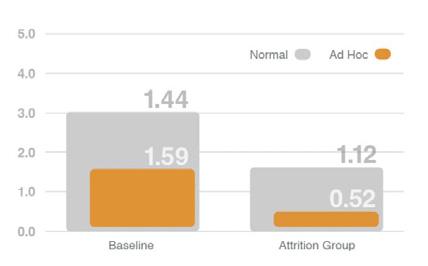
Other notable differences of employees in the attrition group:
● 22 percent less likely to host their own meeting
● Joined late on 7.5 percent more meetings
● Were in meetings with 46 percent more reconnects (participant(s) dropping/rejoining from the meeting, typically from technical problems but not always)
● Generally, in meetings with more attendees (five percent more participants for small group meetings, 12 percent more for meetings of large groups)
Analysis
Taken together, these trends generally point to the attrition group being less engaged with their colleagues – fewer meetings (even at more senior levels), significantly fewer 1:1s, and a lower likelihood of proactive communication (indicated by fewer meetings hosted, significantly fewer ad hoc conversations).
Submit Your Articles Talent Management Excellence presented by HR.com February 2023 49
What Meeting Data Tells Us About Attrition
Nearly any manager will speak to the importance of 1:1s with their direct reports. With the attrition group participating in fewer 1:1s, it’s reasonable to infer they were likely receiving insufficient time with their managers. This is supported by intern and entry levels of seniority seeing 12.5 percent and 26.8 percent reduction in meetings (attrition group compared to baseline, respectively) as well as much higher attrition rates (19.1 percent and 13.2 percent, respectively).
The attrition group joining late to more meetings is interesting but less conclusive. Anecdotally, we’ve found that joining late is not necessarily a sign of disengagement, but more often an indicator of stress and insufficient focus/recovery time. We can’t rule out either scenario from this data.

It’s important to note that this data shows correlation but does not necessarily indicate causality. However, with correlations particularly strong in some areas it’s reasonable to consider whether the data is indicative of factors that led to the decision to part ways. This would be a good area for future research and for organizational leaders to monitor with the help of HR.
The adage that “employees don’t leave their company; they leave their manager” may be an oversimplification but it still rings true. Managing employees is never easy and managing in a hybrid or remote-first environment can be especially challenging. Organizational leaders should pay attention to this data and ensure that managers are providing sufficient 1:1 time to direct reports. Understanding when a contributor is starting to disengage could provide an opportunity to course correct.
Proactively, encouraging and cultivating an “open door” policy for collaboration can be beneficial for those who might be hesitant to reach out for help on their own.

Submit Your Articles Talent Management Excellence presented by HR.com February 2023 50
like to comment?
Mike Tolliver is Product Management Director at Vyopta
Would you
What Meeting Data Tells Us About Attrition
Thank you for partnering with us!
THANK YOU
Paycom (NYSE:PAYC) offers cloud-based human capital management software to help businesses streamline employment processes, from recruitment to retirement. With a robust suite of products including payroll, time and labor management.



Designing better ways to work by providing cutting-edge products and exceptional experiences within HR, Talent, Time Management, Benefits and Payroll.

LEARN MORE
LEARN MORE LEARN MORE
WITH US
PARTNER
The Future of Upskilling and Employee Learning
February 22, 2023
Solving for Today’s Workforce Shortages
February 23, 2023
The State of Financial Wellness
View our Upcoming Virtual Conference Schedule and Register Today!
Innovative (and easy!) Ways to Transform Your People with Upskilling and Reskilling
How Flexible Work Supports Your Hiring and Retention
Pathways to International Hiring Success: How to Find and Hire Top Talent in Any Country
February 22, 2023
February 23, 2023
February 28, 2023
How to Prepare Your Employees for an Economic Slowdown March 1,
View our Upcoming Webcasts Schedule and Register Today!
regisTer
March 1, 2023
regisTer
regisTer
11:00
12:00
ET regisTer VirTuAl eVenTs & hr.COM WebCAsTs uPCOMing www.hr.com/upcoming_webcasts www.hr.com/virtualconferences
AM -
PM
W eb CA s T s
12:00 PM
1:00 PM ET regisTer
-
11:00 AM - 12:00 PM ET regisTer
2023 11:00 AM - 12:00 PM ET regisTer W eb CA s T s V ir T u A l e V en T s
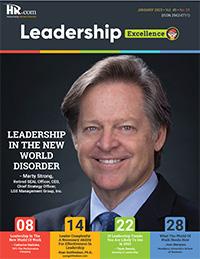
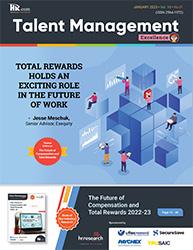
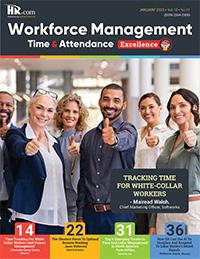
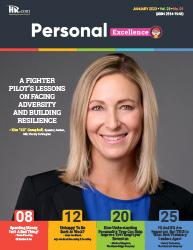
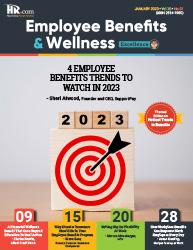


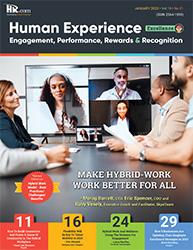
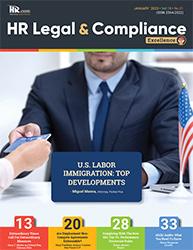

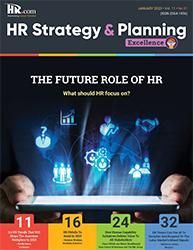
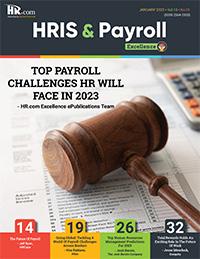

Like to submit an article? Use our online submission form or for more information go to www.hr.com/ExcellencePublications Publications 13 Targeted Publications to reach Your Audience Informing, Educating, Enlightening and Assisting HR professionals in their personal and professional development, the Excellence series offers high-quality content through the publications!

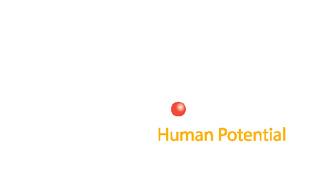
For more information: Phone: 1.877.472.6648 | Email: ePubeditors@hr.com | www.HR.com/epubs Talent Management Excellence February 2023
 - Ollie Henderson, Experienced CEO/Founder and Speaker, Future Work/Life
- Ollie Henderson, Experienced CEO/Founder and Speaker, Future Work/Life


























 Dave Ulrich
Rensis Likert Professor, Ross School of Business, University of Michigan Partner, The RBL Group
Julie Winkle Giulioni Author, Virtual /Live Keynote Presenter, Inc.’s Top 100 Leadership Speakers
Dr. Beverly Kaye CEO, BevKaye&Co.
Dave Ulrich
Rensis Likert Professor, Ross School of Business, University of Michigan Partner, The RBL Group
Julie Winkle Giulioni Author, Virtual /Live Keynote Presenter, Inc.’s Top 100 Leadership Speakers
Dr. Beverly Kaye CEO, BevKaye&Co.



















 Amy Jenkins, Director of Client Strategy & Success, theEMPLOYEEapp
Amy Jenkins, Director of Client Strategy & Success, theEMPLOYEEapp


















 By Cyndi Wenninghoff, Quantum Workplace
By Cyndi Wenninghoff, Quantum Workplace































